Drilling Underway at Highly Prospective Becher Project
HIGHLIGHTS
- +20,000 m aircore (“AC”) drilling program underway in the northern Egina Gold Camp at Novo’s flagship Becher Project, located in the Pilbara, Western Australia.
- Becher is situated adjacent to De Grey Mining Limited’s (ASX:DEG) 10.6 Moz Au (JORC 2012)[1] Mallina Gold Project and 2.5 km south of their new Withnell South discovery[2].
- New results from 1 m split re-assay AC samples closely mirror intercepts from previously reported composite samples[3] and include high grades of:
- 1m @ 7.27 g/t Au from 9 m (F0632) at the intersection of the Irvine and Heckmair trends
- 1 m @ 3.1 g/t Au from 17 m (F519) at Whillans
- 1 m @ 4.27 g/t Au from 17 m (F1393) at Bonatti
- Analysis of multielement geochemistry from the 2022 AC drill program identified prospective hornblende-diorite intrusions (“sanukitoids”) within and around the targeted structural corridors; these intrusions are commonly associated with gold deposits in the Mallina Basin.
- The AC program will test multiple, high-priority structural and intrusion-hosted gold targets, delineated in well-defined and highly anomalous structural corridors and scheduled for completion by end Q2 2023.
- High-priority drill prospects are Heckmair, Irvine and Whillans, based on significant gold and pathfinder anomalies and “sanukitoid” intrusion-related signatures in bottom of 2022 AC drill hole samples.
Commenting on the drill program, Novo Executive Co-Chairman and Acting CEO Mike Spreadborough said, “We are very excited to have recommenced drilling at our flagship Becher Project, as we embark on a targeted +20,000 m follow-up program for this quarter. Importantly, results from our 2022 drill program have confirmed the right geological indicators for discovery success and we believe there is significant prospectivity in the Becher area.”

Drilling at the Heckmair Prospect in April 2023, showing the flat topography in open sand covered plains
VANCOUVER, BC - Novo Resources Corp. (“Novo” or the “Company”) (TSX: NVO, NVO.WT & NVO.WT.A) (OTCQX: NSRPF) is pleased to announce the commencement of a +20,000 m AC drilling program at the Company’s flagship Becher Project (“Becher” or “the Project”), located in the northern sector of the Egina Gold Camp (“Egina”). Results referred to in this news release are not necessarily representative of mineralisation throughout the Egina Gold Camp.
The Becher Area (E47/3673, 100%-owned by Novo) contains multiple high-priority orogenic gold targets under shallow cover in the highly prospective, yet under-explored Mallina Basin. Becher is located ~28 km to the west-southwest of De Grey Mining Limited’s (“De Grey”) Hemi deposit, along an interpreted gold-fertile corridor and only 2.5 km south of their recent Withnell South discovery (Figure 1).
Novo’s 2022 drill program proved to be extremely successful on several fronts:
- The location and tenor of gold assay results from drill sampling have provided confidence in the fertility of the interpreted regional structural corridors;
- Multi-element analysis of bottom-of-hole AC drill samples revealed intrusion-related “sanukitoid” signatures, which are known hosts to gold mineralisation elsewhere in the district;
- The distribution of pathfinder elements such as arsenic, antimony and tungsten (amongst others) defined vectors which have helped finesse understanding on the controls on gold mineralisation; and
- The realisation that the cover sequence is shallow (generally less than 10 m) and is less consequential than expected, is of particular note.
All of these findings have considerable influence in targeting and prioritising the 2023 drill programs.
Final results have also been received for 1 m split samples sourced from 4 m composite samples in the reverse circulation (“RC”) and AC drilling completed in 2022. The new results closely mirror intercepts from previously reported composite samples3 and include high grade assays of (Appendix, Table 1) as follows:
- 1m @ 7.27 g/t Au from 9 m (F0632) at the intersection of the Irvine and Heckmair trends;
- 1 m @ 3.1 g/t Au from 17 m (F519) at Whillans; and
- 1 m @ 4.27 g/t Au from 17 m (F1393) at Bonatti
New results also highlight potential for Intrusion Related Gold (“IRG”) mineralisation at Irvine South and this concept is supported by highly anomalous Au-Cu results and associated pathfinder elements (Au-Ag-Cu-Bi-Mo-Sb) in AC on the most southerly line drilled in 2022. The presence of a strong magnetic target, coincident with the edge of current drill coverage and its location immediately west of the Becher epithermal vein system, provides further support for this possible target style.
The current AC program will test multiple high-priority structural and intrusion-hosted gold targets, which appear similar to De Grey’s Mallina Gold Project2. These targets have been defined by significant gold and pathfinder anomalies in an area of approximately 20 sq km, delineated in anomalous structural corridors at the Heckmair, Irvine and Whillans prospects (Figures 2 to 4). Additional targets are also emerging from partly completed reconnaissance drilling at Lowe and Bonatti. A minimum of 20,000 m of AC will be conducted as part of the program, which commenced in mid-April 2023 and will be completed in June 2023.

Figure 1: Novo’s Pilbara tenure, showing location of the Becher Project within the Egina Gold Camp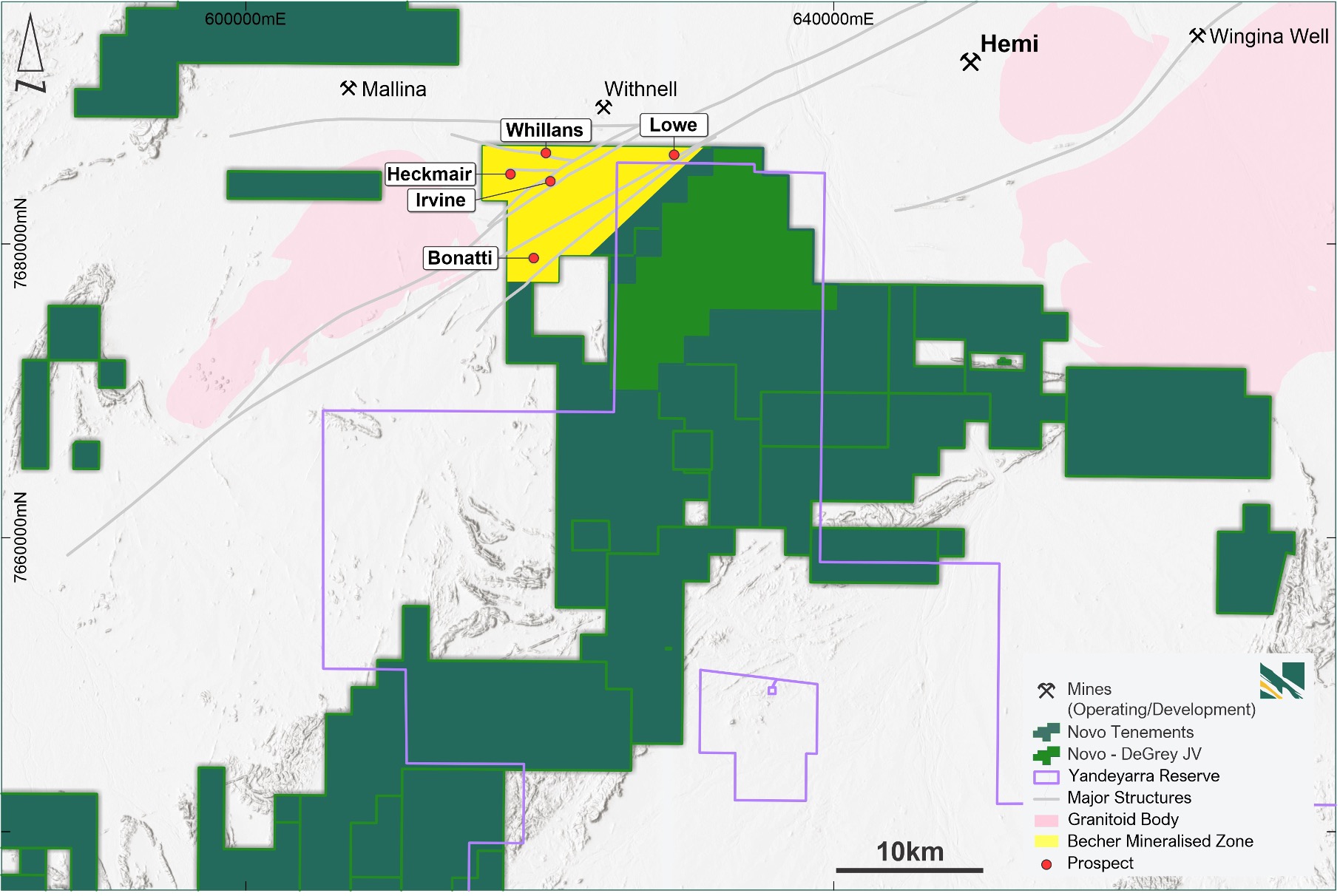
Figure 2: Becher target area showing the position of the De Grey Hemi and Withnell gold discoveries2
2022 EXPLORATION Program details
In mid-2022, Novo commenced a major exploration campaign to test multiple significant shear corridors adjacent to De Grey’s 10.6 Moz Au (JORC 2012)1 Mallina Gold Project. Numerous targets were identified or enhanced utilising an expansive high-resolution aeromagnetic and radiometric survey, coupled with detailed ground gravity surveys in mid-2022. The target style of mineralisation included both structurally controlled orogenic gold and orogenic intrusion-hosted gold, similar mineralisation styles to those at the Hemi gold deposit2.
Mapping in the area highlighted an abundance of transported surficial cover including aeolian sand and sheetwash gravel, driving the interpretation that previous companies’ surface geochemical sampling programs in the area did not effectively test the underlying targets. Two heritage surveys were completed to enable execution of the planned 2022 program.
Systematic broad spaced AC drilling commenced in mid-September 2022 and was completed in mid-December 2022. Drilling totalled 1,413 holes for 31,824 m on 29 sections at 640 m spaced section lines, with occasional 320 m infill lines. The program aimed to test five main targets (Irvine Shear, Whillans Shear, Heckmair Fault and Intrusion, Lowe and Bonatti Shears).
Litho-geochemical studies were conducted on bottom of hole aircore samples that were analysed for Au by fire assay and for 33 multielements by ICP-MS. These studies have enabled Novo to discern between Millindina mafic to ultramafic intrusive suites, possible mafic and komatiitic lavas, “sanukitoid” (hornblende-diorite) intrusions and highly fractionated (more granitic) equivalents. Petrological investigations are pending.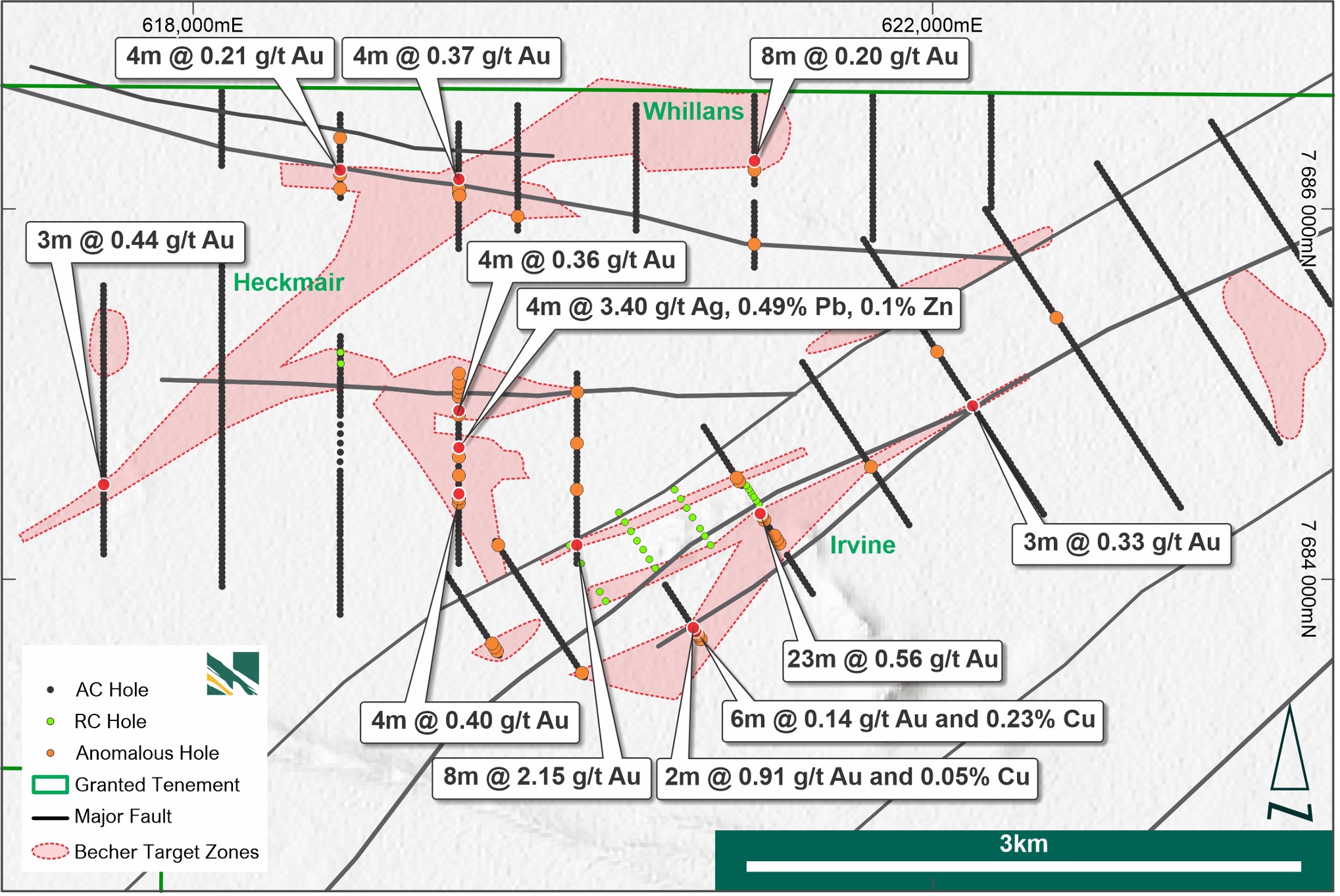
Figure 3: Target map with significant 4 m composite AC drill intercepts >0.1 g/t Au and AC and RC drilling completed in 2022
Heckmair Prospect
The Heckmair prospect is characterised by a significant hornblende-diorite “sanukitoid” intrusive complex which has been dextrally offset by a major NNW-SSE trending fault. Within the complex there are several demagnetised “sanukitoid” phases and fractionated felsic melts. Several high-priority targets have been identified across the intrusion, on the margins and potential extensional zones around the intrusion and within structural offsets cutting through the intrusion, particularly at the southern termination with the Irvine Shear Zone.
Peak AC results for gold3 from recently received 1 m split results (0.1 g/t Au lower cut-off), include:
- 4 m @ 0.40 g/t Au from 12 m (F0738) repeating in new split results as 3 m @ 0.39 g/t Au from 12 m
- 3 m @ 0.44 g/t Au from 20 m (F0858) repeating in new split results as 2 m @ 0.47 g/t Au from 21 m
Highly anomalous base metal results have also been identified adjacent to gold targets at Heckmair, with a peak intercept of 4 m @ 3.4 g/t Ag, 0.49% Pb and 0.1% Zn from 20 m (F0749).
Irvine Prospect
The Irvine prospect is defined by an ENE-WSW trending shear corridor hosting variably sheared sedimentary units, as well as carbonate-silica-altered ultramafic and mafic intrusive rocks of the Millindina Suite. These are bound on the southern shear margin by late “sanukitoid” intrusions. This corridor is extremely anomalous in arsenic and antimony (Figures 5 and 6).
At the Irvine prospect, positive AC drilling results3 listed below, were followed up with 3,541 m of RC drilling from 32 holes drilled on 320 m line spacing.
- 8 m @ 2.15 g/t Au from 8 m (F0632) repeating in new split results as 6 m @ 2.15 g/t Au from 8 m, including 1m @ 7.27 g/t Au from 9 m at the intersection of Irvine and Heckmair trends
- 23 m @ 0.56 g/t Au from 0 m (A0034)
- 15 m @ 0.15 g/t Au from 12 m (A0029)
- 2 m @ 0.40 g/t Au from 3 m (F0123)
Peak RC intercepts previously reported include3:
- 33 m @ 0.493 g/t Au from 33 m (G0005) including 5 m @ 1.28 g/t Au
- 20 m @ 0.406 g/t Au from 32 m (G0016), repeating in new split results as 18 m @ 0.40 g/t Au from 32 m, including 4 m @ 1.1 g/t Au from 45 m
- 24 m @ 0.39 g/t Au from 76 m (G0018) repeating in new split results as 23 m @ 0.39 g/t Au from 77 m, including 10 m @ 0.49 g/t Au from 80 m and 5m @ 0.51 g/t Au from 93 m
Irvine South Prospect
Highly anomalous Au-Cu results were returned from AC drilling at Irvine South (previously reported as 4 m composites[4]), located just to the west of the Becher epithermal vein and include:
- 6 m @ 0.14 g/t Au and 0.23% Cu from 8 m and 4 m @ 0.17 g/t Au and 0.21% Cu from 20 m (A0001)
- 2 m @ 0.91 g/t Au and 473 ppm Cu from 66 m (A0003)
The multielement association of Au-Ag-Cu-Bi-Mo-Sb (and Sn, Ga and Ce) is suggestive of an IRG or related system. Peak values returned include 0.23 ppm Au, 6.7 ppm Ag, 37.2 ppm Bi, 0.68% Cu, 84 ppm Sb and 12.3 ppm Mo.
New understanding based on drill hole geology and related magnetic interpretation suggest a fertile IRG granite may be present directly south of A0001 at Irvine South. The interpreted IRG intrusion and adjacent sedimentary rocks have a strong Au-Ag-Cu-Bi-Mo-Sb multielement signature, lie west of the Becher epithermal vein system and immediately south of the Irvine Shear.
Whillans Prospect
The Whillans Shear is a major E-W to WNW trending break in geology, characterised by strongly sheared sediments with folded ultramafic and mafic lithologies of the Millindina Suite to the north. The Whillans Shear is located 2.5 km to the south of the Withnell gold resource, currently containing 1.6 Moz of gold1. A large ENE trending shear, with significant As-Sb and moderate gold anomalism has recently been defined (the West Shear, Figure 4) truncating the Whillans Shear in the central part of the target area and will be a focus for upcoming exploration.
Peak AC gold results (previously released) including recently received 1 m split results (0.1 g/t Au lower cut-off), include3:
- 8 m @ 0.20 g/t Au from 16 m (F0519) repeating in new split results as 6 m @ 0.64 g/t Au from 16 m including 1 m @ 3.1 g/t Au from 17 m
- 4 m @ 0.37 g/t Au from 20 m (F1136) repeating in new split results as 3 m @ 0.32 g/t Au from 19 m
Bonatti and Lowe Prospects
Drilling during 2022 tested portions of the Bonatti Shear corridor, a 1.8 km wide NE-SW trend with a strike length of approximately 13 km, incorporating the Lowe and Bonatti Prospects. The Bonatti prospect (Figure 7) comprises folded and faulted sediments, ultramafic to mafic lithologies of the Millindina Suite and rare “sanukitoid” intrusions in the northern sector. Encouraging results include 1m @ 4.27 g/t Au from 17 m in F1393 and 1 m @ 1.85 g/t Au from 11 m in F1242.
The Lowe prospect (Figure 7) is characterised by an isoclinally folded tholeiite unit with associated ultramafic lithologies of the Millindina Suite and complex late-stage gabbro and fractionated felsic intrusions. AC logging has identified large zones of intense alteration, coupled with disseminated sulphide minerals, which require further investigation.
PLANNED 2023 DRILLING PROGRAM
Results from recent AC drilling have clearly delineated priority targets including both structurally controlled orogenic gold and intrusion-hosted gold which appear similar to mineralisation with De Greys’ Mallina Gold Project2. The Irvine, Heckmair and Whillans Au targets and the Irvine South Au-Cu target are the primary focus for current AC drilling and follow-up RC drilling. A minimum of 20,000 m of AC will be conducted as part of the current program.
WEST PILBARA DIVESTMENT
The Company also advises that it has commenced a divestment process for base metals on certain tenements in the West Pilbara region of Western Australia. Interested parties are invited to contact Liam Twigger of Argonaut PCF Limited of Perth, Western Australia at ltwigger@argonaut.com.
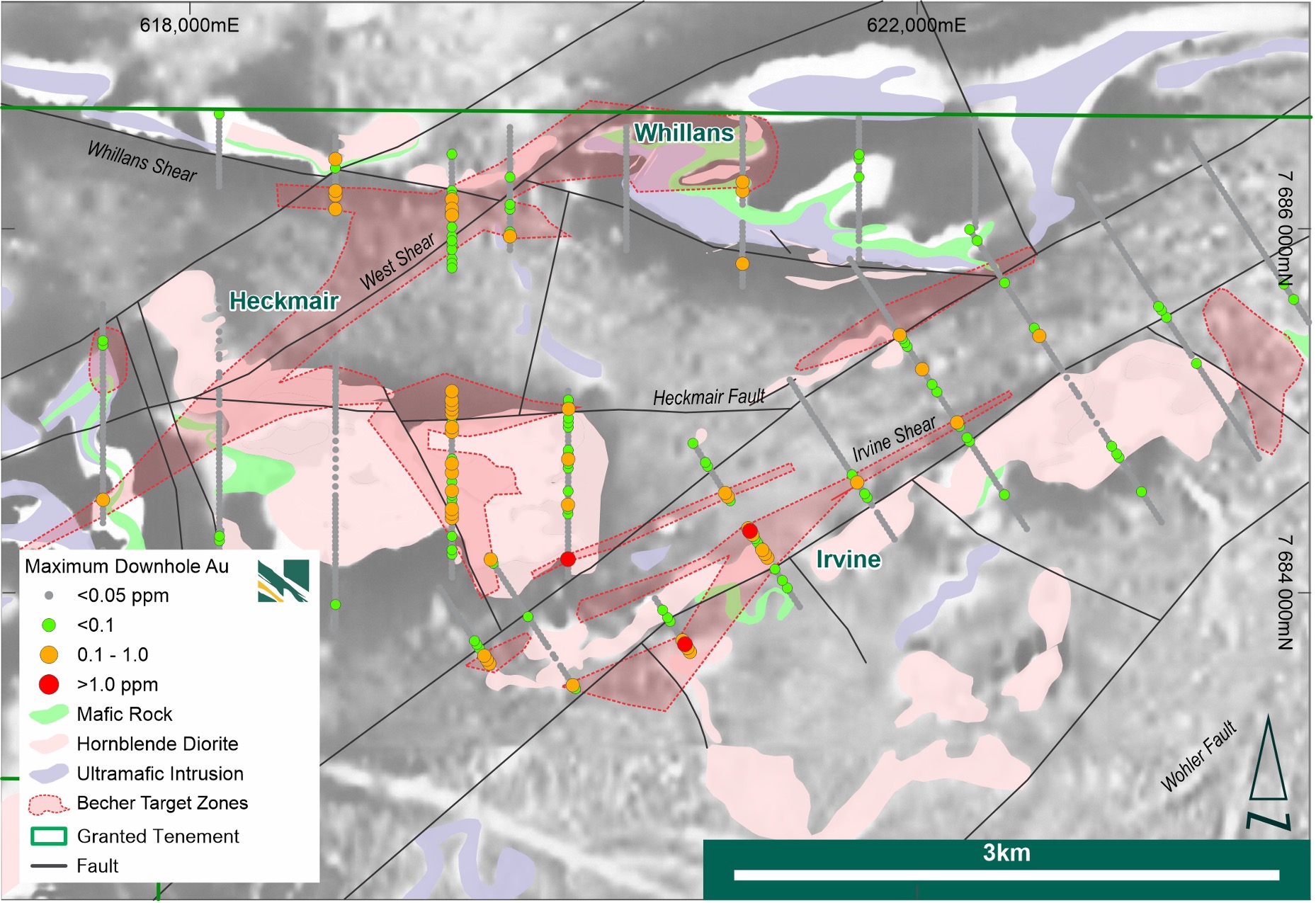
Figure 4: Recent geological Interpretation highlighting major structures, 2022 AC drilling with gold values for bottom of hole samples
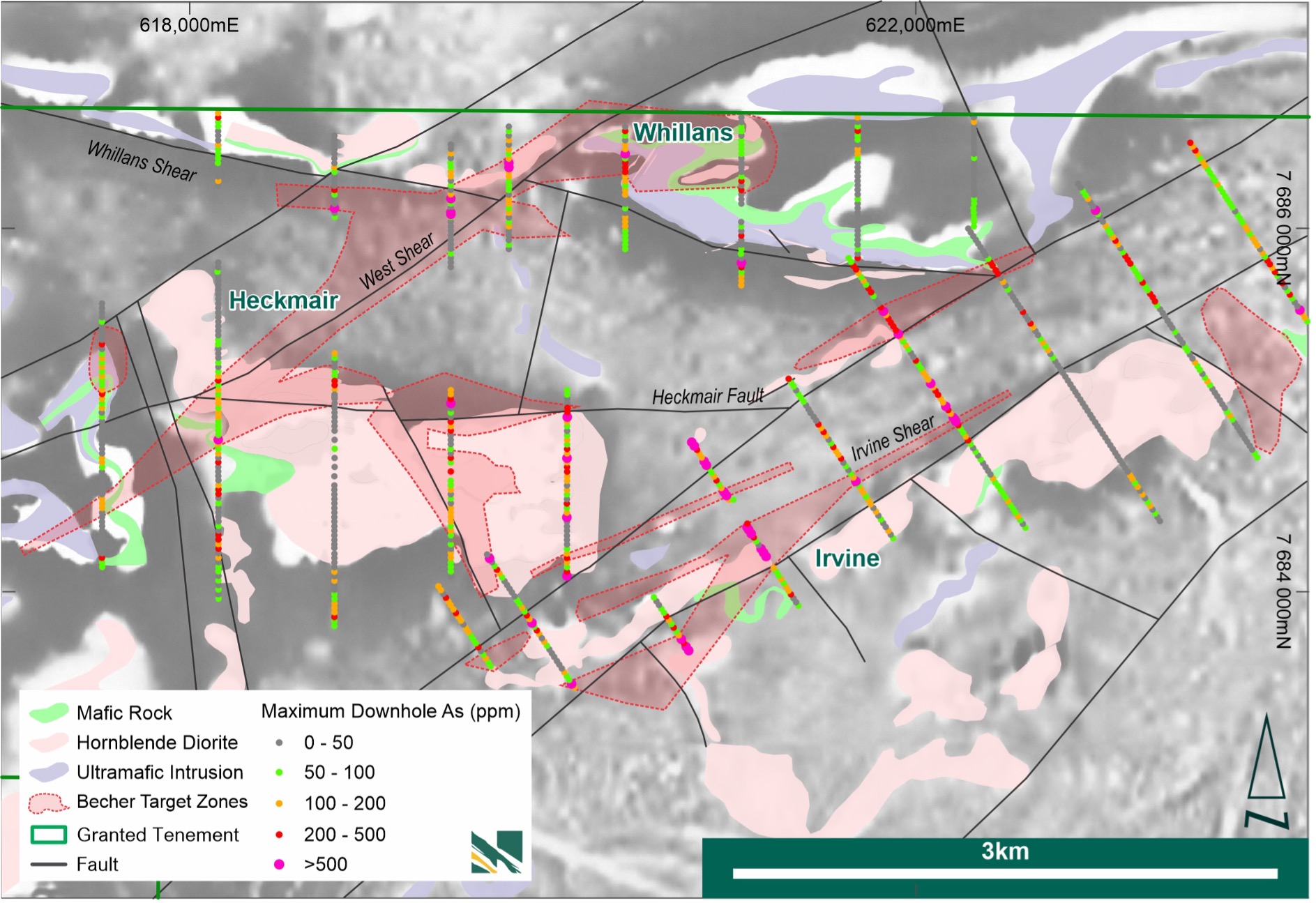
Figure 5: Recent geological interpretation highlighting major structures, 2022 AC drilling with arsenic values for bottom of hole samples

Figure 6: Recent geological interpretation highlighting major structures, 2022 AC drilling with antimony values for bottom of hole samples
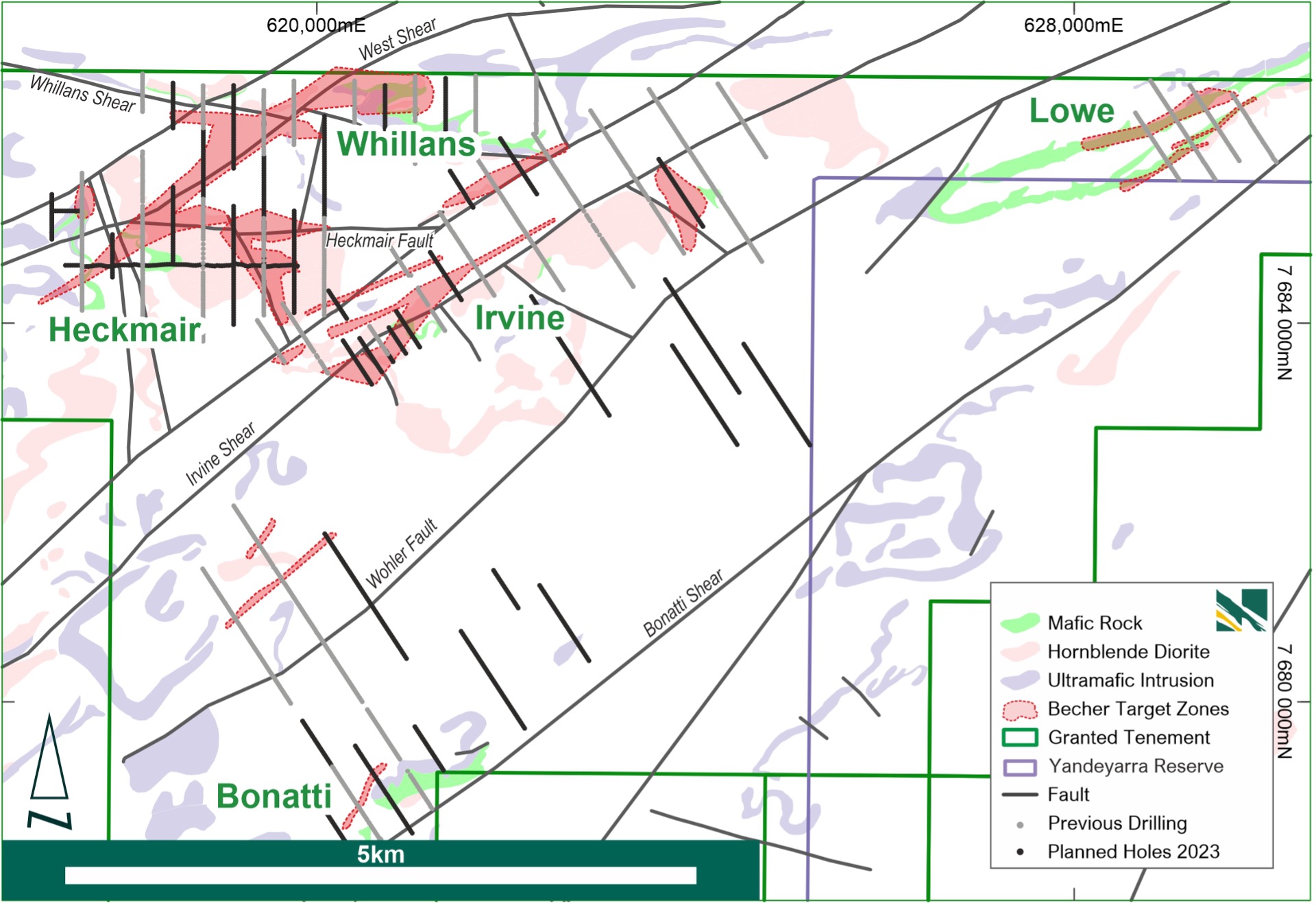
Figure 7: Becher targets defined by AC drilling, drilling completed to date and priority follow up AC overlain on recent geological interpretation
Analytic Methodology
Four-metre composite samples of AC chips were sent to Intertek Genalysis (“Intertek”) in Perth, Western Australia with the entire sample smart crushed to -3mm (NVO02 prep code), with a 500 g split sample analysed for gold using Photon Assay (PHXR/AU01). An additional bottom hole sample from each drill hole (1 to 5 m composite representing rock from the bottom of the drill hole) was assayed using four acid digest and 50 g charge fire assay FA50/OE and for 48 multielement using four acid digest – MS finish (4A/MS). AC drill holes with anomalous gold or base metals have been split through a single tier riffle splitter and are assayed using four acid digest and 50 g charge fire assay FA50/OE and for 48 multielement using four acid digest – MS finish (4A/MS).
QAQC procedures include insertion of a certified blank approximately every 25 samples (4 per hundred), a certified standard approximately every 50 samples (2 per 100) and duplicate sampling (split of 4m composite) at the rate of 4 per hundred. Intertek inserts customized Chrysos certified standards at the rate of 2 per hundred.
RC holes were sampled using spear sampling 4 m composites and 4 m composite samples were sent to Intertek with the entire sample smart crushed to -3 mm (NVOO2 prep code), with a 500 g split sample (1 jar photon assay) analysed for gold using photon assay (PHXR/AU01). QAQC for RC samples are inserted at the rate of 4 standards per 100, 4 blanks per 100 and 4 riffle split duplicates per 100, providing a total of 12% QAQC. Rig split samples for RC were collected as 1m cone splits directly off the rig with the entire sample smart crushed to -3 mm (NVOO2 prep code), with two 500 g split samples (2 jar photon assay) analysed for gold using photon assay (PHXR/AU02) and the results of the two pots have been averaged.
There were no limitations to the verification process and all relevant data was verified by a qualified person as defined in National Instrument 43-101 Standards of Disclosure for Mineral Projects (“NI 43-101”) by reviewing analytical procedures undertaken by Intertek.
QP STATEMENT
Mr. Iain Groves (MAIG), is the qualified person, as defined under NI 43-101, responsible for, and having reviewed and approved, the technical information contained in this news release other than information concerning De Grey’s Mallina Gold Project. Mr. Groves is Novo’s Exploration Manger – West Pilbara.
ABOUT NOVO
Novo explores and develops its prospective land package covering approximately 10,500 square kilometres in the Pilbara region of Western Australia, along with the 22 square kilometre Belltopper Project in the Bendigo Tectonic Zone of Victoria, Australia. In addition to the Company’s primary focus, Novo seeks to leverage its internal geological expertise to deliver value-accretive opportunities to its stakeholders. For more information, please contact Michael Spreadborough at +61-419-329-687 or mike.spreadborough@novoresources.com, or Leo Karabelas at +1-416-543-3120 or leo@novoresources.com.
On Behalf of the Board of Directors,
Novo Resources Corp.
“Michael Spreadborough”
Michael Spreadborough
Executive Co-Chairman and Acting CEO
Forward-looking information
Some statements in this news release contain forward-looking information (within the meaning of Canadian securities legislation) including, without limitation, the anticipated outcome of various exploration activities. These statements address future events and conditions and, as such, involve known and unknown risks, uncertainties and other factors which may cause the actual results, performance or achievements to be materially different from any future results, performance or achievements expressed or implied by the statements. Such factors include, without limitation, customary risks of the resource industry and the risk factors identified in Novo’s annual information form for the year ended December 31, 2022, which is available under Novo’s profile on SEDAR at www.sedar.com. Forward-looking statements speak only as of the date those statements are made. Except as required by applicable law, Novo assumes no obligation to update or to publicly announce the results of any change to any forward-looking statement contained or incorporated by reference herein to reflect actual results, future events or developments, changes in assumptions or changes in other factors affecting the forward-looking statements. If Novo updates any forward-looking statement(s), no inference should be drawn that the Company will make additional updates with respect to those or other forward-looking statements.
APPENDIX
Table 1: Becher Area – Aircore drilling Intercepts > 0.1 g/t Au with up to 2 m internal dilution comparing new 1 m aircore split results with the original aircore speared composite sample.
|
Original composite spear samples |
1m split samples |
|||||||||
|
Hole ID |
Depth From m |
Depth To m |
Width (m) |
Au (g/t) |
Hole ID |
Depth From m |
Depth To m |
Width (m) |
Au (g/t) |
|
|
F0506 |
12 |
16 |
4 |
0.12 |
F0506 |
12 |
14 |
2 |
0.17 |
|
|
F0519 |
16 |
24 |
8 |
0.2 |
F0519 |
16 |
22 |
6 |
0.64 |
|
|
including |
17 |
18 |
1 |
3.1 |
||||||
|
F0521 |
20 |
28 |
8 |
0.14 |
F0521 |
21 |
28 |
7 |
0.14 |
|
|
F0567 |
8 |
12 |
4 |
0.13 |
F0567 |
8 |
12 |
4 |
0.13 |
|
|
F0573 |
12 |
16 |
4 |
0.1 |
F0573 |
12 |
16 |
4 |
0.10 |
|
|
F0574 |
4 |
8 |
4 |
0.1 |
F0574 |
4 |
8 |
4 |
0.10 |
|
|
F0594 |
8 |
12 |
4 |
0.13 |
F0594 |
8 |
11 |
3 |
0.19 |
|
|
F0597 |
0 |
4 |
4 |
0.21 |
F0597 |
0 |
4 |
4 |
0.02 |
|
|
F0598 |
4 |
8 |
4 |
0.13 |
F0598 |
6 |
7 |
1 |
0.24 |
|
|
F0605 |
16 |
21 |
5 |
0.12 |
F0605 |
16 |
21 |
5 |
0.12 |
|
|
F0632 |
8 |
16 |
8 |
2.14 |
F0632 |
8 |
14 |
6 |
2.15 |
|
|
including |
9 |
10 |
1 |
7.27 |
||||||
|
F0644 |
8 |
12 |
4 |
0.11 |
F0644 |
8 |
12 |
4 |
0.04 |
|
|
F0654 |
4 |
10 |
6 |
0.24 |
F0654 |
3 |
10 |
7 |
0.20 |
|
|
F0724 |
8 |
12 |
4 |
0.14 |
F0724 |
11 |
12 |
1 |
0.19 |
|
|
F0738 |
12 |
16 |
4 |
0.4 |
F0738 |
12 |
15 |
3 |
0.39 |
|
|
F0739 |
12 |
16 |
4 |
0.17 |
F0739 |
9 |
13 |
4 |
0.20 |
|
|
F0740 |
12 |
16 |
4 |
0.17 |
F0740 |
11 |
14 |
3 |
0.23 |
|
|
F0744 |
12 |
16 |
4 |
0.12 |
F0744 |
12 |
16 |
4 |
0.12 |
|
|
F0747 |
12 |
16 |
4 |
0.11 |
F0747 |
12 |
16 |
4 |
0.05 |
|
|
F0748 |
0 |
4 |
4 |
0.23 |
F0748 |
1 |
2 |
1 |
0.82 |
|
|
F0755 |
12 |
16 |
4 |
0.12 |
F0755 |
11 |
14 |
3 |
0.19 |
|
|
F0756 |
12 |
16 |
4 |
0.35 |
F0756 |
12 |
14 |
2 |
0.61 |
|
|
F0757 |
28 |
32 |
4 |
0.1 |
F0757 |
31 |
32 |
1 |
0.26 |
|
|
F0759 |
12 |
16 |
4 |
0.11 |
F0759 |
13 |
14 |
1 |
0.13 |
|
|
F0760 |
12 |
16 |
4 |
0.32 |
F0760 |
13 |
16 |
3 |
0.46 |
|
|
F0761 |
8 |
16 |
8 |
0.23 |
F0761 |
11 |
14 |
3 |
0.47 |
|
|
F0762 |
12 |
16 |
4 |
0.14 |
F0762 |
11 |
15 |
4 |
0.12 |
|
|
F0764 |
8 |
16 |
8 |
0.12 |
F0764 |
6 |
7 |
1 |
0.13 |
|
|
F0764 |
11 |
13 |
2 |
0.32 |
||||||
|
F0858 |
20 |
23 |
3 |
0.44 |
F0858 |
21 |
23 |
2 |
0.47 |
|
|
F0902 |
20 |
24 |
4 |
0.1 |
F0902 |
22 |
23 |
1 |
0.16 |
|
|
F0903 |
8 |
12 |
4 |
0.17 |
F0903 |
10 |
14 |
4 |
0.22 |
|
|
F0936 |
12 |
16 |
4 |
0.19 |
F0936 |
13 |
19 |
6 |
0.20 |
|
|
F0939 |
4 |
8 |
4 |
0.12 |
F0939 |
4 |
8 |
4 |
0.12 |
|
|
F0940 |
8 |
12 |
4 |
0.33 |
F0940 |
5 |
6 |
1 |
0.14 |
|
|
F0940 |
9 |
12 |
3 |
0.4 |
||||||
|
F0941 |
8 |
12 |
4 |
0.11 |
F0941 |
5 |
6 |
1 |
0.13 |
|
|
F0941 |
9 |
12 |
3 |
0.15 |
||||||
|
F0983 |
0 |
4 |
4 |
0.15 |
F0983 |
0 |
4 |
4 |
0.15 |
|
|
F1016 |
8 |
12 |
4 |
0.22 |
F1016 |
9 |
12 |
3 |
0.24 |
|
|
F1027 |
8 |
12 |
4 |
0.12 |
F1027 |
8 |
12 |
4 |
0.12 |
|
|
F1064 |
8 |
12 |
4 |
0.13 |
F1064 |
8 |
12 |
4 |
0.13 |
|
|
F1075 |
16 |
21 |
5 |
0.14 |
F1075 |
19 |
21 |
2 |
0.20 |
|
|
F1115 |
12 |
16 |
4 |
0.18 |
F1115 |
15 |
17 |
2 |
0.30 |
|
|
F1121 |
8 |
12 |
4 |
0.19 |
F1121 |
10 |
12 |
2 |
0.20 |
|
|
F1134 |
20 |
24 |
4 |
0.2 |
F1134 |
19 |
26 |
7 |
0.24 |
|
|
F1135 |
20 |
24 |
4 |
0.12 |
F1135 |
20 |
24 |
4 |
0.12 |
|
|
F1136 |
20 |
24 |
4 |
0.37 |
F1136 |
19 |
22 |
3 |
0.30 |
|
|
F1138 |
12 |
16 |
4 |
0.27 |
F1138 |
13 |
15 |
2 |
0.44 |
|
|
F1242 |
8 |
13 |
5 |
0.49 |
F1242 |
11 |
12 |
1 |
1.85 |
|
|
F1260 |
4 |
8 |
4 |
0.1 |
F1260 |
4 |
8 |
4 |
0.10 |
|
|
F1393 |
16 |
21 |
5 |
0.29 |
F1393 |
17 |
18 |
1 |
4.27 |
Table 2: Becher Area – Significant RC drilling intercepts > 0.1 g/t Au for 2022 drilling with up to 2 m internal dilution for new 1 m split samples of original 4 m composite samples.
|
Hole ID |
Depth From m |
Depth To m |
Width (m) |
Au (g/t) |
|
G0016 |
32 |
50 |
18.00 |
0.4 |
|
including |
45 |
49 |
4.00 |
1.08 |
|
G0017 |
4 |
16 |
12.00 |
0.13 |
|
G0017 |
47 |
48 |
1.00 |
0.35 |
|
G0018 |
48 |
56 |
8.00 |
0.10 |
|
G0018 |
77 |
100 |
23.00 |
0.39 |
|
including |
80 |
90 |
10.00 |
0.49 |
|
and |
93 |
98 |
5.00 |
0.51 |
|
G0019 |
9 |
10 |
1.00 |
0.35 |
|
G0019 |
17 |
21 |
4.00 |
0.28 |
|
G0019 |
85 |
106 |
21.00 |
0.2 |
|
G0022 |
16 |
20 |
4.00 |
0.12 |
|
G0022 |
28 |
33 |
5.00 |
0.24 |
|
G0022 |
38 |
45 |
7.00 |
0.17 |
|
G0022 |
50 |
64 |
14.00 |
0.28 |
|
including |
54 |
60 |
6.00 |
0.46 |
|
G0022 |
116 |
121 |
5.00 |
0.13 |
|
G0023 |
10 |
11 |
1.00 |
0.2 |
|
G0023 |
36 |
38 |
2.00 |
0.40 |
|
G0023 |
58 |
60 |
2.00 |
0.22 |
|
G0023 |
84 |
85 |
1.00 |
0.87 |
|
G0023 |
89 |
92 |
3.00 |
0.27 |
|
G0023 |
112 |
115 |
3.00 |
0.28 |
|
G0024 |
75 |
79 |
4.00 |
0.14 |
|
G0024 |
86 |
103 |
17.00 |
0.17 |
|
including |
101 |
103 |
2.00 |
0.57 |
Table 3: Becher Area – New 4 m composite drilling intercepts from the final 2022 RC drill holes > 0.1 g/t Au with up to 2m internal dilution.
|
Hole ID |
Depth From m |
Depth To m |
Width (m) |
Au (g/t) |
|
G0026 |
56 |
60 |
4.00 |
0.16 |
|
G0027 |
8 |
20 |
12.00 |
0.16 |
|
G0027 |
68 |
72 |
4.00 |
0.23 |
|
G0028 |
48 |
56 |
8.00 |
0.16 |
|
G0028 |
76 |
80 |
4.00 |
0.17 |
|
G0031 |
52 |
56 |
4.00 |
0.26 |
|
G0031 |
120 |
127 |
7.00 |
0.23 |
|
G0032 |
28 |
36 |
8.00 |
0.28 |
[1] De Grey has reported that its Hemi deposit at the Mallina Gold Project is comprised of Measured Mineral Resources of 4.7 Mt @ 1.7 g/t Au for 265 koz Au, Indicated Mineral Resources of 153.4 Mt @ 1.3 g/t Au for 6,590 koz Au, and Inferred Mineral Resources of 92.6 Mt @ 1.3 g/t Au for 3,779 koz Au, as those categories are defined in the JORC Code (as defined in National Instrument 43-101 Standards of Disclosure for Mineral Projects). Refer to De Grey’s public disclosure record for further details.
[2] While certain aspects of Becher mineralisation seem analogous to that at the Mallina Gold Project as disclosed by De Grey Mining’s Mallina Gold Project, mineralisation is not necessarily representative of mineralisation throughout the Becher Area or the Egina Gold Camp.
[3] Refer to the Company’s news release dated February 14, 2023.
[4] Refer to the Company’s news release dated October 27, 2022.

